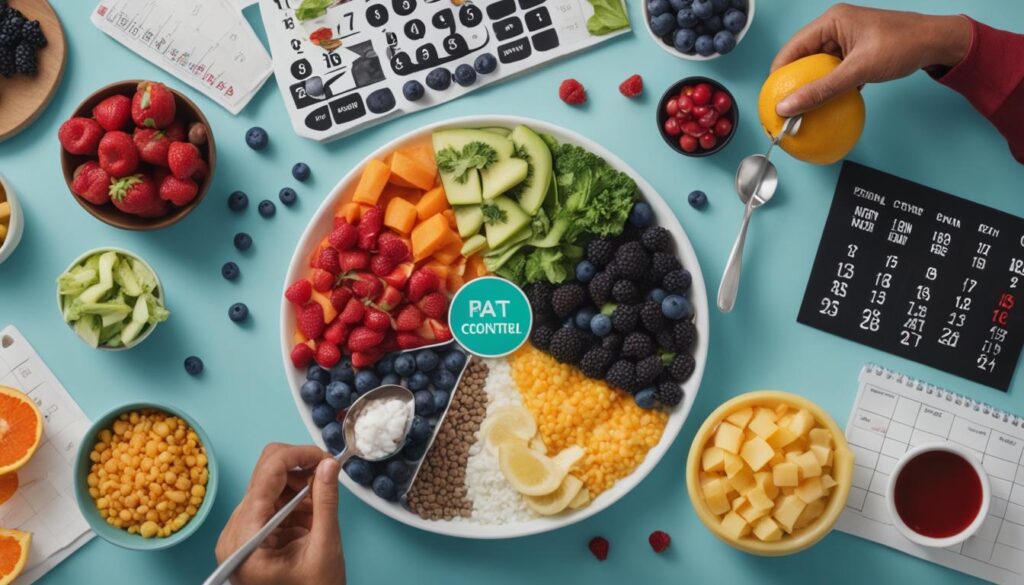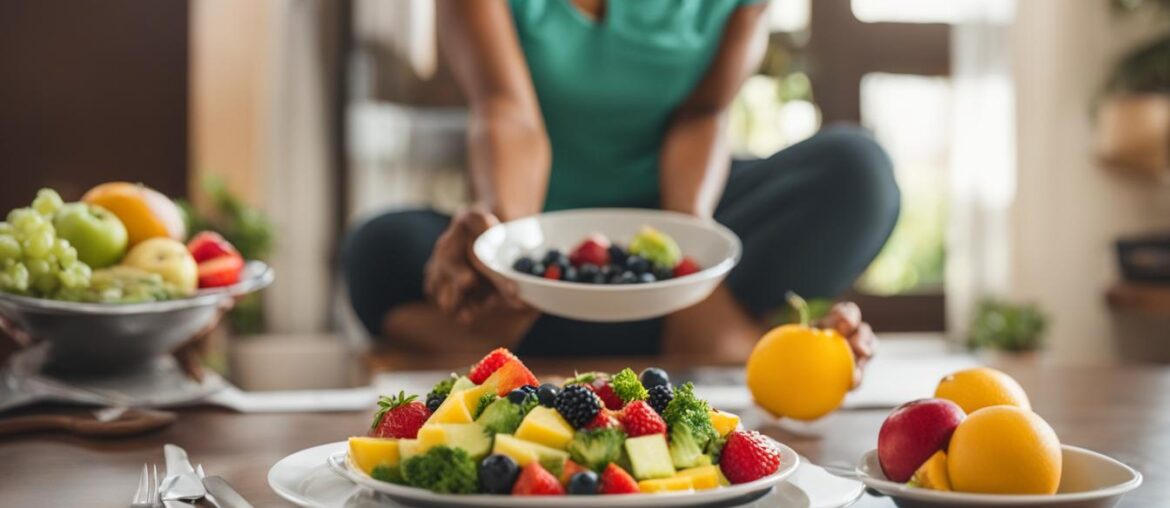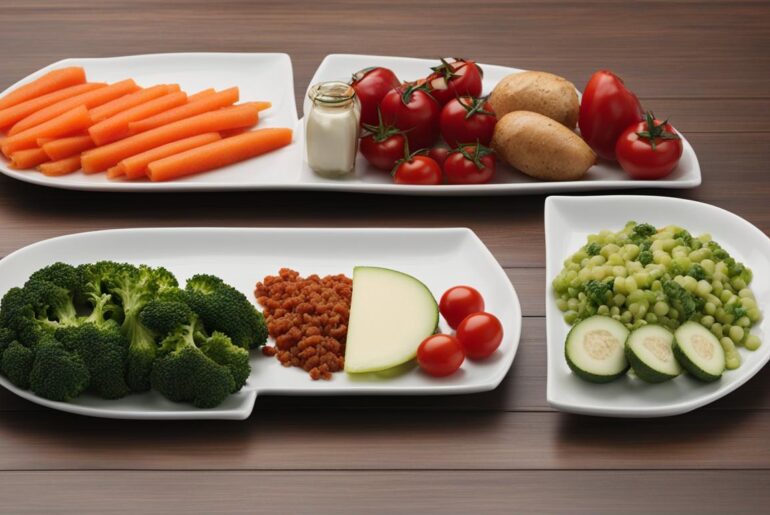In today’s fast-paced world, maintaining a healthy lifestyle is more important than ever. One crucial aspect of a balanced diet is portion control. By understanding and implementing effective strategies for managing food portions, you can take control of your eating habits and promote overall well-being (check this post out). In this article, I will explore practical techniques and tips to help you master food portions and achieve your health goals.
Key Takeaways:
- Portion control is essential for weight loss and maintaining a balanced diet.
- Overcoming emotional eating and developing healthy eating habits are crucial in portion control (see my post here).
- Mindful eating and understanding portion sizes are effective techniques for portion control.
- Pre-portioning meals, navigating restaurant menus wisely, and tracking progress can help incorporate portion control into daily life.
- Achieving health goals requires consistent portion control and maintaining a balanced diet.
Understanding Portion Control
Portion control plays a crucial role in maintaining a healthy lifestyle and managing weight. It involves consciously consuming an appropriate amount of food to meet your body’s nutritional needs without overindulging. By understanding the difference between portion size and serving size, and making mindful choices, you can effectively control your food intake and support your weight management goals.
When it comes to portion control, it’s essential to differentiate between portion size and serving size. Portion size refers to the amount of food you choose to consume, while serving size is a standardized measurement determined by nutritional guidelines. By being aware of the recommended serving sizes and being mindful of the portions you serve yourself, you can ensure you’re getting the right balance of nutrients your body needs.
Mindful choices are an integral part of portion control. It involves paying attention to hunger cues, listening to your body, and being aware of portion sizes. Mindful eating encourages you to savor each bite and focus on the flavors and textures of your food. This not only enhances your eating experience but also allows your brain to register feelings of fullness, preventing overeating.
Effective portion control is beneficial for weight management. By consuming proper portions, you can avoid consuming excess calories and create a calorie deficit, which is essential for weight loss. Additionally, portion control ensures that you’re getting a well-balanced intake of nutrients, promoting overall health and well-being.
Common Challenges in Portion Control

When it comes to portion control, there are several common challenges that many of us face. These challenges can hinder our progress and make it difficult to maintain healthy eating habits. In this section, I will discuss some of the most prevalent challenges in portion control and provide strategies to overcome them.
Emotional Eating
One of the biggest obstacles to portion control is emotional eating. It often involves consuming food as a way to cope with negative emotions or stress. When we turn to food for comfort, it’s easy to lose sight of appropriate portion sizes and overeat.
“Emotional eating is like using an umbrella to try and fix a leaky roof. It may temporarily provide relief, but it doesn’t address the root cause of the problem.” – Anonymous
To overcome emotional eating, it’s important to identify the emotional triggers that lead to overeating. Instead of relying on food, find alternative coping mechanisms such as exercise, journaling, or seeking support from loved ones. By addressing the underlying emotions, you can break free from the cycle of emotional eating and regain control over your portion sizes.
Mindless Eating
Mindless eating is another challenge when it comes to portion control. It occurs when we consume food without paying attention to portion sizes or the act of eating itself. This often leads to overeating and a lack of satisfaction from our meals.
One strategy to combat mindless eating is to practice portion awareness. Slow down while eating and savor each bite. Take the time to appreciate the flavors and textures of your food. By eating mindfully, you can tune in to your body’s hunger and fullness cues, preventing overeating and promoting a sense of satisfaction with smaller portions.
Social and Environmental Influences
Social settings and environmental cues can also influence our portion sizes. When dining out, we may be tempted by larger portion sizes or unhealthy options. In these situations, it’s important to make mindful choices.
When eating out, opt for healthier options on the menu or share meals with others to control portion sizes. By choosing smaller portions or sharing meals, you can enjoy dining out while still maintaining control over your portion sizes.
At home, consider using smaller plates and bowls. Research has shown that using smaller dishware can visually make portions look more substantial, leading to a greater sense of satisfaction with less food.
Here is a helpful table summarizing the common challenges in portion control and strategies to overcome them:
| Common Challenges | Strategies to Overcome |
|---|---|
| Emotional Eating | Identify emotional triggers and find alternative coping mechanisms such as exercise or seeking support from loved ones. |
| Mindless Eating | Practice portion awareness by eating slowly and savoring each bite. |
| Social and Environmental Influences | Make mindful choices when dining out, opt for healthier options or share meals with others. At home, use smaller plates and bowls to visually make portions look more substantial. |
By understanding and addressing these common challenges in portion control, you can overcome them and establish healthier eating habits. Stay tuned for the next section where I will discuss effective strategies for portion control that you can implement in your daily life.
Effective Strategies for Portion Control
When it comes to portion control, there are several effective strategies you can implement to help you manage your food intake and make healthier choices. By utilizing mindful eating techniques, pre-portioning and meal planning, understanding portion sizes, and managing emotional and social triggers, you can take control of your eating habits and achieve your health goals.
Mindful Eating Techniques
Mindful eating is a powerful tool for portion control and overall well-being. By slowing down and savoring each bite, you can fully appreciate the flavors and textures of your food while giving your brain time to recognize feelings of fullness. This can help prevent overeating and promote a healthier relationship with food.
Pre-Portioning and Meal Planning
One of the most effective ways to control portion sizes is by pre-portioning your meals and snacks. Prepare your meals in advance and divide them into individual containers, ensuring that each contains the appropriate amount of food. This not only helps you maintain consistent portion sizes, but it also eliminates the temptation to overeat.
Additionally, meal planning allows you to make informed choices about what you eat and helps you avoid impulsive decisions that can lead to overeating. By planning your meals ahead of time, you can ensure that you have nutritious options readily available and reduce the likelihood of excessive portion sizes.
Understanding Portion Sizes
Being aware of proper portion sizes is crucial for effective portion control. Familiarize yourself with visual cues to estimate appropriate portion sizes. For example, a serving of meat should be about the size of a deck of cards, and a portion of carbohydrates should be about the size of your fist. By understanding these visual references, you can better gauge how much food you should be consuming.
Managing Emotional and Social Triggers
Emotional and social triggers can often lead to overeating. It’s important to identify these triggers and find alternative coping mechanisms. Instead of turning to food for comfort, engage in activities like exercise, meditation, or seeking support from loved ones. By managing these triggers, you can avoid using food as a means of emotional fulfillment and practice healthier portion control.
In social settings, communicate your portion preferences to those around you. Let your friends and family know about your portion control goals, and ask for their support. When attending gatherings or events, focus on enjoying the company and engaging in activities rather than solely on the food. This shift in mindset can help create a supportive environment that encourages mindful eating and portion control.
Overall, mastering portion control requires a combination of mindful eating techniques, pre-portioning and meal planning, understanding portion sizes, and managing emotional and social triggers (see my post here). By incorporating these strategies into your daily life, you can take control of your eating habits, achieve a healthy balance, and make significant progress towards your health goals.
| Benefits of Effective Portion Control | Tips for Implementing Portion Control |
|---|---|
| Weight management | Eat slowly and savor each bite |
| Improved digestion | Pre-portion meals and snacks |
| Reduced risk of chronic diseases | Understand visual cues for portion sizes |
| Enhanced overall well-being | Identify emotional triggers |
| Communicate portion preferences in social settings |
Incorporating Portion Control into Daily Life

When it comes to maintaining healthy portion sizes, it’s important to incorporate portion control strategies into your daily life (check out my post on portion control strategies here). By doing so, you can make mindful choices and stay on track with your health goals. Here are some practical tips to help you navigate various situations:
Navigating Restaurant Menus
When eating out, it can be challenging to maintain portion control. However, there are strategies you can use to make healthier choices:
- Opt for appetizers or smaller portion sizes instead of ordering a full-size meal.
- Choose dishes that include lean proteins, whole grains, and vegetables.
- Share a meal with a friend or family member to reduce your portion size.
By being mindful of your choices at restaurants, you can enjoy a delicious meal while still sticking to your portion control goals.
Pre-Portioning Snacks and Desserts
Snacks and desserts can be a major source of overeating if not properly portioned. To avoid mindless snacking, try pre-portioning these items into smaller containers:
- Measure out servings of snacks, such as nuts or chips, into individual bags or containers.
- Divide desserts, like cookies or brownies, into smaller portions to satisfy your sweet tooth without going overboard.
Having these portions ready to grab ensures you stay on track with your portion control goals, even when snack cravings strike.
Striking a Balance During Holidays and Special Occasions
Holidays and special occasions often involve indulgent meals and treats. While it’s important to enjoy these festivities, you can still practice portion control:
- Focus on filling your plate with vegetables and lean proteins before indulging in higher-calorie dishes.
- Take small portions of your favorite holiday treats instead of loading up your plate.
- Listen to your body’s hunger and fullness cues, stopping when you feel satisfied rather than overstuffed.
By striking a balance between enjoying the special occasion and practicing portion control, you can savor the flavors while still maintaining a healthy lifestyle.
Tracking Progress and Staying Motivated
To stay motivated on your portion control journey, it’s essential to track your progress and celebrate small victories along the way:
“Progress is progress, no matter how small. Celebrate each step you take towards healthier portion control.”
Keep a food diary to record your meals and portion sizes, helping you stay accountable. Celebrate your achievements, no matter how small, to stay motivated and encouraged on your portion control journey. Seek support from friends, family, or support groups who can provide encouragement and help you stay on track.
Tracking your progress and celebrating milestones can be a powerful motivator to continue incorporating portion control into your daily life.
| Benefits of Incorporating Portion Control | How to Apply Portion Control in Daily Life |
|---|---|
| Weight management | Measure and portion meals in advance |
| Healthier eating habits | Practice mindful eating techniques |
| Better digestion | Slow down and chew food thoroughly |
| Improved energy levels | Include a variety of nutrient-dense foods |
Incorporating portion control into daily life is a powerful tool for maintaining a balanced diet and achieving your health goals. By navigating restaurant menus, pre-portioning snacks and desserts, striking a balance during holidays and special occasions, tracking your progress, and staying motivated, you can successfully incorporate portion control into your lifestyle.
Conclusion
Mastering food portions through effective portion control strategies is essential for achieving a healthier lifestyle. By understanding the principles of portion control, overcoming common challenges, and implementing practical techniques, you can take control of your eating habits and improve your overall well-being.
Embracing the power of portion control allows you to enjoy the positive impact it will have on your health and quality of life. With mindful choices and conscious portion control, you can savor your meals while maintaining a balanced diet and achieving your health goals.
Remember, portion control is not about depriving yourself but about finding the right balance. It’s about nourishing your body with the appropriate amount of food it needs, preventing overeating, and supporting weight management. By incorporating portion control into your daily life, you can discover the joy of enjoying food in moderation while still achieving optimal health.




